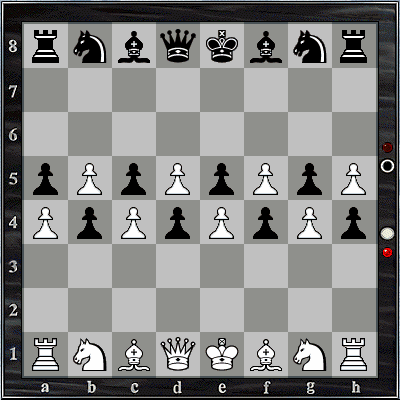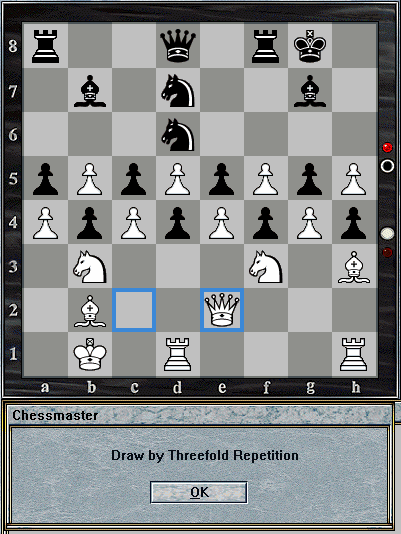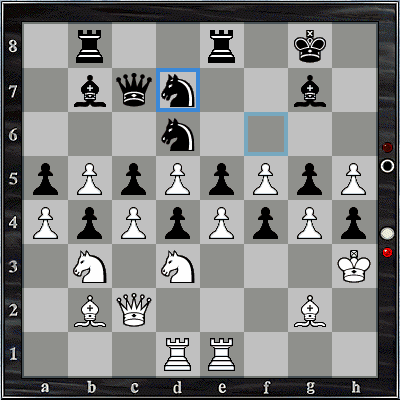The "Quaker Chess" Challenge:
I was recently considering the question: could we position the Chess pieces
at the beginning of the game in an alternate but symmetric way that would give
Black the best chances of an even game with White?
This resulted in another question: is there a way of positioning the pieces
symmetrically that would discourage either player from capturing or moving aggressively?
Such an arrangement would (typically) lead to a draw, since the first player
to become the aggressor would be at an immediate disadvantage.
I believe I have found such an initial setup. I have referred to this setup as
"Quaker Chess", given the historically non-aggressive nature of most
Quakers. The setup is (I find) elegant & aesthetically pleasing. It is also
an interesting puzzle (at least, to me). In the position that follows, Castling
is possible, en passant capture is irrelevant, and the double-pawn move is not
an option. Here the "Quaker Chess" setup:
 |
The FEN of the Quaker Chess position:
rnbqkbnr/8/8/pPpPpPpP/PpPpPpPp/8/8/RNBQKBNR w KQkq - 0
1
|
Here is the Quaker Chess Challenge:
Suppose White is a very aggressive player who despises drawn games. Indeed,
s/he finds a draw nearly as painful as a loss.
Suppose Black is a very defensive and drawish player who finds draws nearly
as delightful as victories.
Is there a line of play that would enable White to become the aggressor without
immediately putting himself/herself at a disadvantage? If not, what is the least
disadvantage White can incur in pursuing a victory?
I don't have the answer, which is where you come in. I would be interested to
know your preferred line of play as White. Remember, a draw is like a loss to
you!
That's the challenge! Your favorite line of play, however short or long,
may be posted at:
The Chessmaster Discussion Board (at Chessgames.com)
Testing solutions
The Chessmaster 8000 (Chessmaster.com)
program can easily be configured to play against itself or against any of its
internal "virtual opponents" In initial tests, the Chessmaster pairings, when
confronted with the "Quaker Chess" initial position, have either played
to draws without breaching the "Quaker Pawn Line" (by threefold repetition),
or Black has won the contests after the pawn line has been breached. This is
the first symmetrical starting position I have ever found for which
Black wins more often than White (and I've tested quite a few!)
To be sure, Chess programs are not ideal for playing unusual setups of this
type. Furthermore, Chessmaster may not be the best program for the job. Future
tests with such strong programs as Shredder, Fritz, and Junior are intended!
Of course, the question naturally arises: apart from being a puzzle of sorts,
is this setup useful in any other way? Well, it certainly would be an interesting
way for a stronger player to give odds to a weaker player. Rather than "pawn
and move", the stronger player might play White, with the understanding
that a draw would be considered a win for Black. Just a thought.
Thanks!
Update: Scores from Chessmaster 8000 Pair-ups - including a
12-move draw, a 29-move draw, & a 158-move victory for Black (!)
Game #1: A 12-move Draw
Below are the moves from a game played between the main Chessmaster engine against the main Chessmaster engine. It was drawn in a mere 12 moves! Each side was given 5 minutes only
for the entire game, so the moves were fast.
The game was played on a 450 MHz machine, with 128 MB of RAM (I believe).
The result was a draw. The "Quaker Pawn Wall" was not breached.
[Event "The Quaker Chess Challenge"]
[Site "The Quaker Chess Challenge Mega-Emporium"]
[Date "8-23-2004"]
[Round "1"]
[White "Chessmaster"]
[Black "Chessmaster"]
[Result "1/2-1/2"]
1. Nf3 Nd7 2. Nbd2 Bb7 3. Bb2 Nh6 4. Bh3 Nf7 5. Qe2 Bg7 6. Nb3 Nd6 7. O-O-O
O-O 8. Kb1 Rf7 9. Qc2 Rf8 10. Qe2 Rb8 11. Qc2 Ra8 12. Qe2 1/2-1/2 [drawn by
threefold repetition]
The final position is shown below.
 |
Game #2: A 29-move Draw
This game also pitted the main engine of Chessmaster against itself, but the fact that each side was given 90 minutes for the game renders this 29-move game more interesting.
The game was played on a 450 MHz machine, with 128 MB of RAM (I believe).
The result was a draw. The "Quaker Pawn Wall" was not breached.
[Event "The Quaker Chess Challenge"]
[Site "Café de la Régence [not really]"]
[Date "8-23-2004"]
[Round "1"]
[White "Chessmaster"]
[Black "Chessmaster"]
[Result "1/2-1/2"]
1. Nd2 Nd7
2. Bb2 Bb7
3. Nh3 Nh6
4. Nf2 Nf7
5. Bg2 Bg7
6. O-O O-O
7. Qc2 Qc7
8. Rfe1 Rae8
9. Nb3 Nd6
10. Rab1 Rb8
11. Nd2 Rfe8
12. Nh3 Nf7
13. Nf2 Nb6
14. Nd3 Nh6
15. Nf2 Nd7
16. Nb3 Nf7
17. Rbd1 Nd6
18. Nh3 Nf7
19. Nf2 Nd6
20. Kh2 Ra8
21. Nd3 Nf6
22. Bf3 Nd7
23. Bh1 Nf6
24. Kh3 Nd7
25. Bg2 Rab8
26. Kh2 Nf6
27. Kh3 Nd7
28. Kh2 Nf6
29. Kh3 Nd7
1/2-1/2 [drawn by threefold repetition]
The final position is shown below.
Game #3: A 158-move victory for Black!
Below are the 158 moves (!) from a contest
between Chessmaster's "Virtual Fischer", playing White, and Chessmaster's "Virtual
Petrosian", playing Black.
These two virtual players were chosen because the virtual Fischer personality
is described as "aggressive", and the virtual Petrosian personality is described
as "defensive".
Note: if I'm scanning the moves correctly, no capture is made until move 44 when
Black captures first. The second capture is also made by Black on move 70. Why
White promotes the pawn to a Rook on move 152 is not clear. Of course, the Rook
will be captured immediately, so it doesn't matter. Are we seeing some kind of
anti-stalemate loop in the engine function in an unintended way? Or is Chessmaster
just having a good chuckle? Perhaps by this point, Chessmaster is just fritzed
out.
The game was played on a 450 MHz machine, with 128 MB of RAM (I believe). Each
player was given 90 minutes.
The result was a victory for Black (Virtual Petrosian)!
[Event "The Quaker Chess Challenge"]
[Site "Quaker Chess Olympiad XIV"]
[Date "8-23-2004"]
[Round "1"]
[White "Chessmaster's Virtual Fischer"]
[Black "Chessmaster's Virtual Petrosian"]
[Result "0-1"]
1. Nd2 Nd7 2. Bb2 Bg7 3. Nh3 Nh6 4. Nf2 Bb7 5. Bg2 O-O 6. O-O Qc7 7. Re1 Nf7
8. Qc2 Rfe8 9. Nb3 Rab8 10. Nd3 Nd6 11. Rad1 Ra8 12. Re2 Rad8 13. Kh2 Rb8 14.
Rf1 Ra8 15. Kg1 Rad8 16. Ree1 Rb8 17. Rb1 Ra8 18. Rfe1 Rad8 19. Re2 Rb8 20.
Rbe1 Rbc8 21. Ba1 Ra8 22. Rd1 Rab8 23. Rb1 Re7 24. Ree1 Ra8 25. Bb2 Ree8 26.
Rbd1 Rab8 27. Nf2 Rbd8 28. Rf1 Ra8 29. Rde1 Nb6 30. Nd2 Rad8 31. Rb1 Kh8 32.
Nh3 Qe7 33. Rfd1 Kh7 34. Nf2 Qc7 35. Nd3 Re7 36. Rf1 Rf8 37. Ra1 Rb8 38. Nb3
Nd7 39. Rad1 Ree8 40. Rf2 Kg8 41. Re1 Ra8 42. Rd2 Rad8 43. Nf2 Qb6 44. h6 Bxh6
45. Rdd1 Bg7 46. Re2 Kh7 47. Rf1 Qc7 48. Ra1 Rh8 49. Rd1 Rb8 50. Ree1 Rbe8 51.
Nh3 Bf6 52. Nd2 Nb6 53. Bf1 Kg7 54. Be2 Kf7 55. Ra1 Rhf8 56. Kh2 Rd8 57. Nf2
Kg8 58. Rf1 Rfe8 59. Nb3 Ra8 60. Nh3 Kf7 61. Nd2 Rg8 62. Rab1 Raf8 63. Rfe1
Re8 64. Nf2 Rd8 65. Rbd1 Rge8 66. Nh3 Rf8 67. Ra1 Rg8 68. Rac1 Qe7 69. Nf2 Rgf8
70. Nb3 Nxa4 71. Nxa5 Nxb2 72. Qxb2 Qc7 73. Nxb7 Qxb7 74. Ra1 Ra8 75. Qc2 Qb6
76. Bf1 Rh8 77. Kg1 Ra7 78. Rxa7+ Qxa7 79. Nd3 Ra8 80. Bg2 Qc7 81. Nc1 Ra3 82.
Nb3 Qa7 83. Rb1 Ke7 84. Rb2 Qc7 85. Qe2 Kf8 86. Rb1 Ke8 87. Bf3 Qa7 88. Rb2
Kf7 89. Qd3 Qd7 90. Rb1 Qc7 91. Qe2 Qa7 92. Bg2 Ra2 93. b6 Qa3 94. Qd3 Nb7 95.
Nc1 Bd8 96. Bf1 Ra1 97. Nb3 Rxb1 98. Qxb1 Bxb6 99. Bd3 Nd6 100. Kh1 Qa6 101.
Kg1 Qa7 102. Kg2 Bd8 103. Qb2 Kg8 104. Qb1 Bf6 105. Nd2 Kf7 106. Nb3 Kg7 107.
Nd2 Kf8 108. Nb3 Kf7 109. Nd2 Ke7 110. Nb3 Ke8 111. Kf3 h3 112. Qc2 Nb7 113.
Kf2 Qa3 114. Qb1 Be7 115. Kg1 Qa6 116. Kh2 Qh6 117. Qe1 Bd8 118. Qf1 Qh4 119.
Qxh3 Qf2+ 120. Qg2 Qe3 121. Qh3 f3 122. Qf1 Bb6 123. Kg3 Qf4+ 124. Kh3 Nd6 125.
Qc1 Nf7 126. Qd2 Kd7 127. Bc2 Ke7 128. Qxf4 exf4 129. Nd2 Ne5 130. Bd1 d3 131.
Bb3 Bc7 132. Bd1 Bd6 133. Bb3 f2 134. Kg2 Nxg4 135. Kf3 Ne3 136. Kxf2 g4 137.
Ba4 Be5 138. Bb3 Bd4 139. Ke1 g3 140. Ba4 Nxc4 141. d6+ Kd8 142. Nf3 Bf2+ 143.
Kd1 Nb2+ 144. Kc1 Nxa4 145. f6 Be3+ 146. Kb1 Ke8 147. f7+ Kxf7 148. d7 Ke7 149.
Ka2 c4 150. e5 Nc3+ 151. Ka1 g2 152. d8=R Kxd8 153. e6 g1=Q+ 154. Nxg1 Bxg1
155. Kb2 d2 156. e7+ Kxe7 157. Ka1 d1=Q+ 158. Kb2 Qb1# 0-1
Comments are always welcome.



